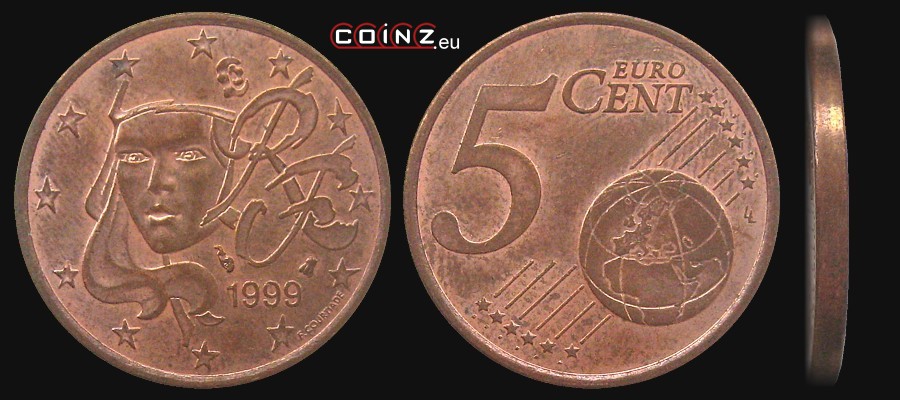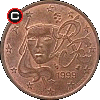5 euro cent FRANCE (from 1999)


| diameter: | weight: | thickness: | alloy: |
| 21.25 mm | 3.92 g | 1.67 mm | steel Cu-plated |
obverse:
in the coin centre personification of France - head of Marianne facing slightly left; on the right stylised letters: RF (RÉPUBLIQUE FRANÇAISE - French Republic); below year of issue; at the edge a ring of twelve five-pointed stars - symbol of the European Union
reverse:
edge:
plain
issue date:
1 I 2002
withdrawal date:
in circulation
designer:
Fabienne Courtiade (signature F.COURTIADE along the edge after year of issue in the obverse), Luc Luycx (initials LL on the right side of the globe in the reverse)
mint:
 La Monnaie de Paris (The Paris Mint), Pessac (mint mark above the first digits of year of issue in the obverse, above the last digits of year of issue privy mark of mint's director Pierre Rodier - bee - in years 1999-2000, or Gérard Buquoy - horseshoe - in years 2001-2002, or Serge Levet - heart - in 2003, or Hubert Larivière - horn - in years 2004-2010, or Yves Sampo - rosette - from 2011)
La Monnaie de Paris (The Paris Mint), Pessac (mint mark above the first digits of year of issue in the obverse, above the last digits of year of issue privy mark of mint's director Pierre Rodier - bee - in years 1999-2000, or Gérard Buquoy - horseshoe - in years 2001-2002, or Serge Levet - heart - in 2003, or Hubert Larivière - horn - in years 2004-2010, or Yves Sampo - rosette - from 2011)

mintage:
| 1999 | 616 192 000 | bee | + 35 000 in annual boxed sets |
| 2000 | 280 064 000 | bee | + 35 000 in annual boxed sets |
| 2001 | 217 289 477 | horseshoe | + 35 000 in annual boxed sets |
| 2002 | 186 283 000 | horseshoe | + 165 290 in annual boxed sets |
| 2003 | 100 977 000 | heart | + 242 342 in annual boxed sets |
| 2004 | 60 162 000 | horn | + 160 000 in annual boxed sets |
| 2005 | 20 174 000 | horn | + 120 000 in annual boxed sets |
| 2006 | 132 049 000 | horn | + 80 000 in annual boxed sets |
| 2007 | 130 062 000 | horn | + 60 000 in annual boxed sets |
| 2008 | 218 232 000 | horn | + 60 000 in annual boxed sets |
| 2009 | 184 710 000 | horn | + 60 000 in annual boxed sets |
| 2010 | 184 000 000 | horn | + 55 500 in annual boxed sets |
| 2011 | 145 000 000 | rosette | + 45 500 in annual boxed sets |
| 2012 | 139 000 000 | rosette | + 42 000 in annual boxed sets |
| 2013 | 142 000 000 | rosette | + 28 000 in annual boxed sets |
| 2014 | 130 000 000 | rosette | + 28 000 in annual boxed sets |
| 2015 | 97 000 000 | rosette | + 28 000 in annual boxed sets |
varieties:
1999 - between stars and the lower edge of the reverse squares or rectangles like in reverses of coins with face value 2 euro cent


mint marks:
interesting facts:
last update: 12 VIII 2015
coins catalogue :: katalog monet :: münzkatalog :: catalogue de monnaies :: catálogo de monedas :: catalogo monete :: каталог монет :: κέρματα κατάλογος :: COINZ.eu
© 2010-2025 :: Adam Kubicki :: COINZ.eu :: All rights reserved.


